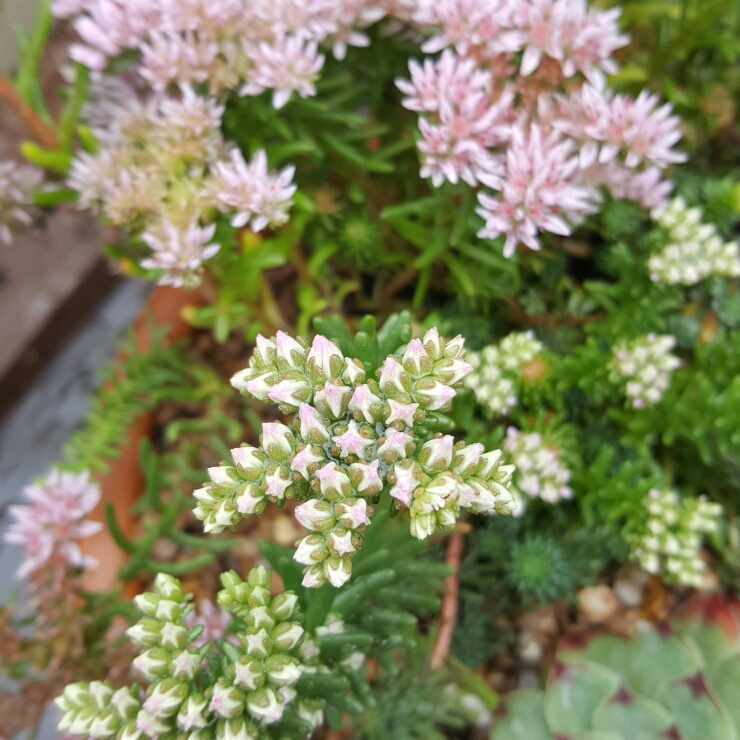
Sedum Pallidum
Sedum 'Pallidum'
As per ICN: Description (according to IHSP 2003) : Glandular-pubescent perennial herbs, usually with branching and rooting sterile shoots at the base of the ascending flowering shoots. Leaves alternate, densely imbricate, sessile, shortly spurred, linear to linear-oblong, 6 - 10 mm or rarely longer, terete to semiterete, obtuse to acute, glaucous-green, sometimes red. Inflorescences : Flowering branches to 15 cm, inflorescences cymes with usually 2 - 4 cincinni. FIower 5-merous, sepals broadly sessile, basally slightly connate, triangular, acute, petals free, lanceolate, white or rarely pinkish, keel often red, filament glabrous, anthers red. Cytology: 2n = 20, 40, 60 Although generally perennial, the usually non-flowering shoots of some plants may occasionally all produce inflorescences. These apparently monocarpic specimens can be distinguished from the strictly annual S. eriocarpum by the basally ascending and usually much-branched stems. [H. 't Hart, B. Bleij & V. V. Byalt] Sedum, or Stonecrop, is a large genus of flowering plant which has fleshy, succulent leaves, fleshy stems, and has clusters of small, starry flowers.
Contributed by @gardentagssucculentexpert
-
Full sun to partial shade
-
Very little water
-
Frost Hardy: 23F (-5°C)
-
All soil conditions
Common name
Sedum 'Pallidum'
Latin name
Sedum Pallidum
type
Perennial
family
Crassulaceae
ph
4.5 - 7.5 Acid - Neutral
Plant & bloom calendar
-
Best time to plant
-
When the plant will bloom
full grown dimensions
 0.45 M
0.30 M
0.45 M
0.30 M
Sedum Pallidum
As per ICN: Description (according to IHSP 2003) : Glandular-pubescent perennial herbs, usually with branching and rooting sterile shoots at the base of the ascending flowering shoots. Leaves alternate, densely imbricate, sessile, shortly spurred, linear to linear-oblong, 6 - 10 mm or rarely longer, terete to semiterete, obtuse to acute, glaucous-green, sometimes red. Inflorescences : Flowering branches to 15 cm, inflorescences cymes with usually 2 - 4 cincinni. FIower 5-merous, sepals broadly sessile, basally slightly connate, triangular, acute, petals free, lanceolate, white or rarely pinkish, keel often red, filament glabrous, anthers red. Cytology: 2n = 20, 40, 60 Although generally perennial, the usually non-flowering shoots of some plants may occasionally all produce inflorescences. These apparently monocarpic specimens can be distinguished from the strictly annual S. eriocarpum by the basally ascending and usually much-branched stems. [H. 't Hart, B. Bleij & V. V. Byalt] Sedum, or Stonecrop, is a large genus of flowering plant which has fleshy, succulent leaves, fleshy stems, and has clusters of small, starry flowers.
Flowering
From Mid Summer TO Mid Autumn
Most sedum flower through the summer months and into early Autumn
Planting
From Early Spring TO Mid Spring
Plant divisions or seeds in Spring
Propagating by seed
From Early Spring TO Mid Spring
Sow seeds in Spring
Propagating by division
From Mid Spring TO Late Summer
Dividing plants for propagation can be done at any time during the growing season, and divisions will grow readily.
















